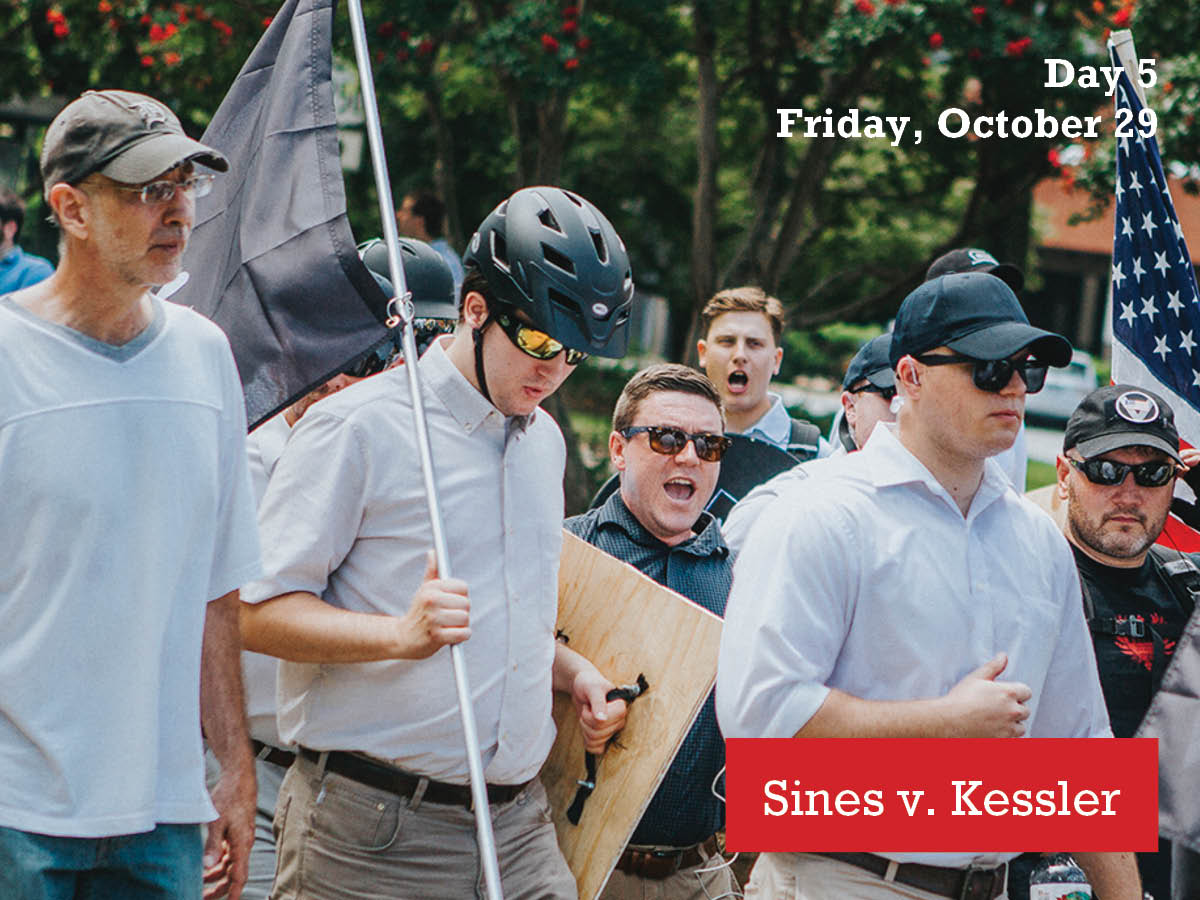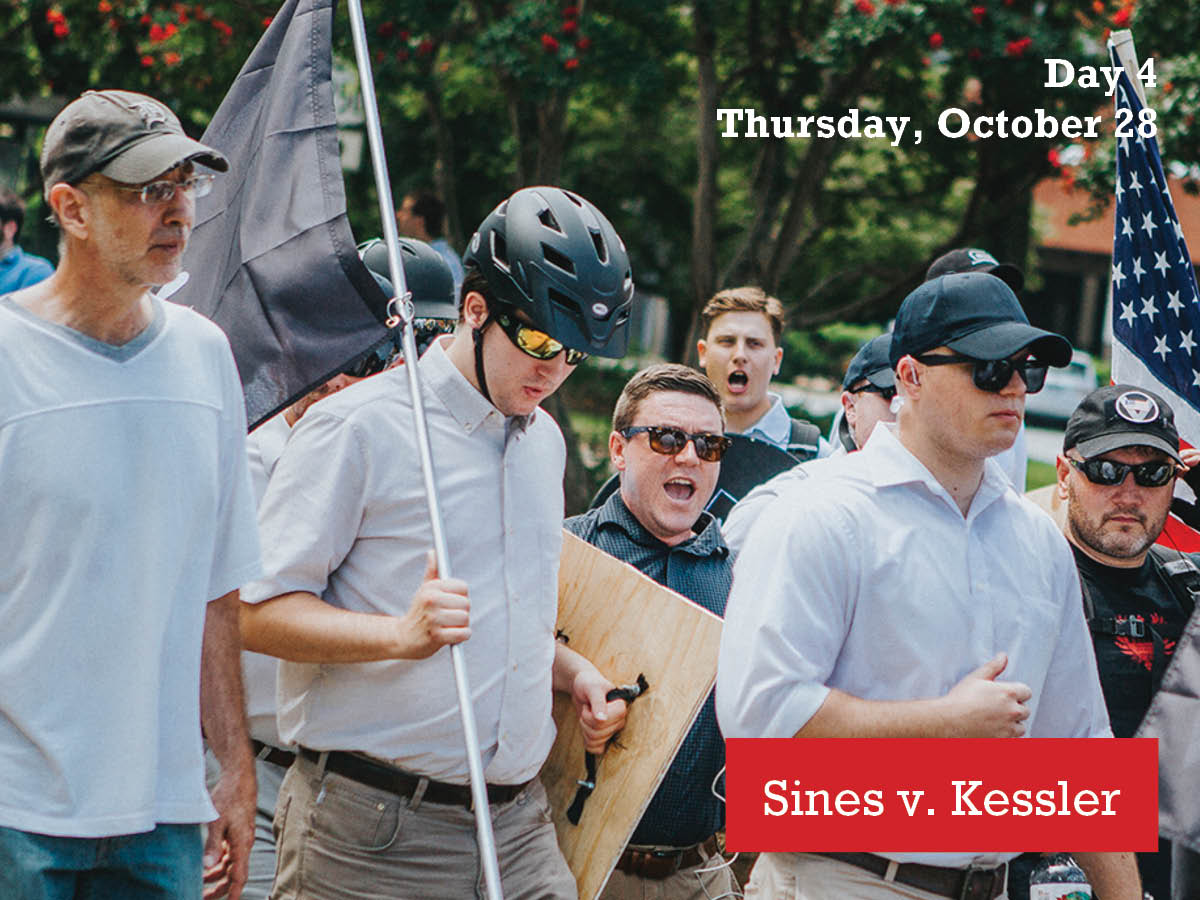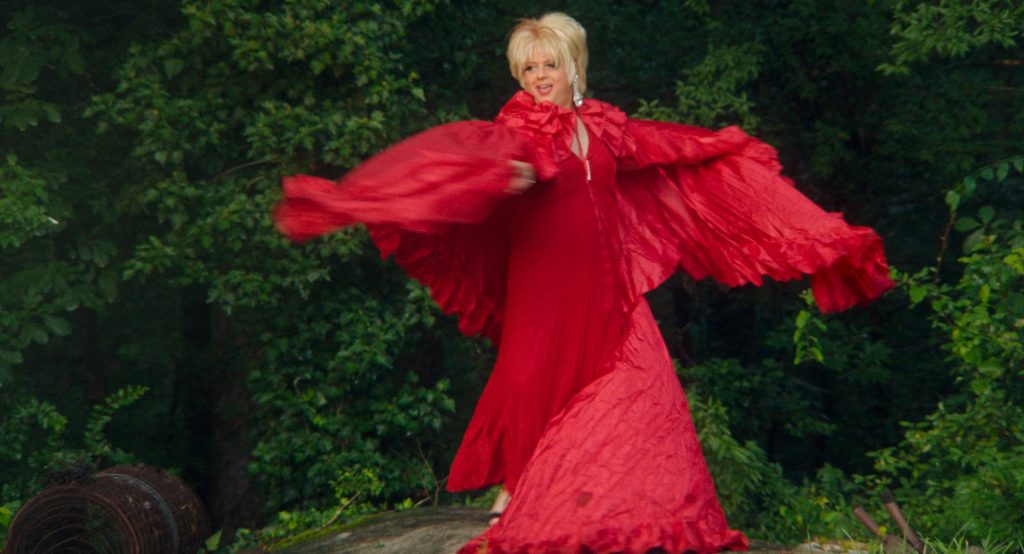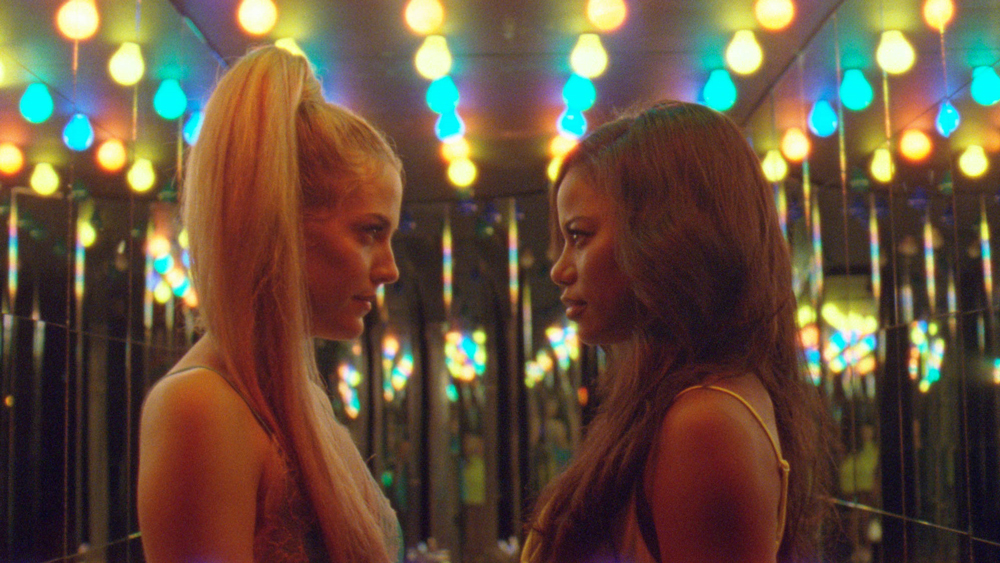Each day, we’ll have the latest news from the courtroom in the Sines v. Kessler Unite the Right trial. For coverage from previous days, check the list of links at the bottom of this page.
On the fifth day of the Sines v. Kessler trial, plaintiffs’ attorneys brought to the stand two former UVA students. Natalie Romero and Devin Willis are among the nine plaintiffs in the case. They both counterprotested at the Friday night torch rally on UVA Grounds and at the Unite the Right rally the following day in August 2017.
Romero took the stand first. She described the fear of that weekend and the injuries she suffered in the August 12 car attack. Later, after a grueling and emotional three hours of testimony in the morning, Romero also faced cross examination from Christopher Cantwell and Richard Spencer, the two defendants representing themselves, whom she and her fellow plaintiffs accuse of conspiring to commit racially motivated violence that permanently scarred her.
“I just heard loudness. Almost like thunder. Like the earth was growling, essentially,” Romero recalled of the moments before the racist mob arrived at the Thomas Jefferson statue, where she was huddled with a group of about 15 fellow UVA students.
Now 24, Romero said she could make out the mob’s chants, including “blood and soil” and “white power,” as the angry group approached.
“There’s another one I hate repeating,” said Romero, who sobbed at times on the stand. “I hear it in my nightmares. I literally hear the same cadence to the ‘You will not replace us.’ That one was just so terrifying.”
A Houston, Texas, native, Romero said she was the first in her family to attend college, and came to the University of Virginia on multiple scholarships. In addition to ROTC, she was part of the Posse program, which provides students from low-income families special advisors before and during their time at UVA, and creates a cohort to provide support.
She had completed an internship working on environmental issues that summer, and was in high spirits as she returned to Charlottesville from a road trip to Houston that Friday.
“I took my last selfie of my face without what it looks like now,” she said, referencing scars on her face and body that resulted from the August 12 car attack. “Then I met up with friends, and we had dinner together.”
When Romero’s dinner group learned that the white nationalists were planning to march to UVA that night, she and two friends, including fellow plaintiff Willis, headed to the Thomas Jefferson statue in front of the Rotunda. Willis also testified about his terror as the mob of white nationalists arrived.
“This ocean of light and flames starts spilling over both sides of the steps,” said Willis, recalling the xenophobic chanting.
“They rush the entire area and surround all of us in a matter of seconds,” he said.
Like Romero, Willis had also just completed his first year at UVA in the summer of 2017. He was a member of the Black Student Alliance and recalled being targeted by the mob at the statue. Men sprayed his feet with lighter fluid and threw lit torches towards him.
“I thought their strategy was going to be to burn us alive,” he said.
Both Romero and Willis were eventually able to escape and rinse mace from their eyes.
Despite the terror of that night, the former students testified that they were not deterred from heading to downtown Charlottesville the following morning for a planned counterprotest of the Unite the Right rally.
“I figured because it was nighttime, that’s why they felt they could do that. Well, there aren’t going to be torches tomorrow,” Romero explained. “I wanted to be there for the community and with the community.”
Willis said he expected the Unite the Right rally to be similar to the July 8, 2017, KKK rally in Court Square Park, which he had attended and which did not end in violence. He had helped organize a peaceful counterprotest on Saturday, August 12, through a People’s Action for Racial Justice committee.
“I wasn’t in a negative mood,” Willis said. “I thought the day still had the potential to be good and peaceful.”
But worse was to come.
Both witnesses recounted the unforgettable scenes of that day: armed white nationalists gathering in downtown Charlottesville, carrying Confederate flags and shields, wearing T-shirts with swastikas and images of Hitler.
As violence began to erupt near Market Street Park, Romero saw a group of white women and joined hands with them.
“Honestly, I’m in this line thinking, ‘I’m okay. Why would they be violent to a group of women that are doing nothing? Especially, I’m with white women. I‘m a light-skinned Latina, not that many shades deeper.”
Groups of men still singled her out, she said.
“I got spit on by people who hate me and think I should not be alive and that I threaten their existence,” she said, her voice rising and cracking with emotion. “I’m just trying to go to school, man. I’m just trying to get out of poverty.”
Willis also had a violent encounter with Unite the Right protesters on Saturday, when his group of counterprotesters was assaulted by what he described as a militia brigade of older men.
“They eventually knock everybody down,” Willis said. “I am a nonviolent person, so I fled.”
When news reached the counterprotesters that the rally had been technically canceled by emergency order before it officially began, Romero joined the celebratory group of counterprotesters that would eventually have a fatal encounter with James Fields and his Dodge Charger on Fourth Street.
As Romero’s group rounded the corner from Water Street to Fourth Street, the impact of Fields’ car came without warning, she said.
“The next thing I know is just darkness. You know in the movies when it’s like beeeeep…. Bmm bmmm… I could hear my heart beating,” Romero said. “Like war scenes where they were just hit, and it’s just flashing.”
Dunn showed the jury photos of Romero soon after the impact, appearing dazed, her face and arms covered in blood. She suffered a fractured skull, damage to her teeth, and severe abrasions on her face and body that have left scars.
“My confidence was destroyed,” Romero said, describing the impact of her injuries, which forced her to withdraw from school for a semester and left her with chronic headaches and vision problems. “I can live with my scars. I have to. But I hate it.”
On cross examination, attorneys for defendants, including Jason Kessler, expressed condolences for Romero and kept their questions brief, asking mostly if she could recall seeing specific defendants that Friday night on UVA Grounds or on Saturday at the rally.
“I’m not sure,” Romero answered repeatedly.
The two defendants representing themselves in the case, Spencer and Cantwell, were more aggressive in their cross examinations, and Romero was forced to engage directly with two of the men she and the other plaintiffs have accused.
“So you wanted to seek out the protesters, is what I understand,” Spencer asked. “You wanted to see a spectacle of some kind or get your word in?”
“In no way did I want to meet protesters,” Romero responded calmly, noting she is a history buff and believed the events unfolding would be historic. “I wanted to see it with my own eyes.”
“When the car incident occurred, did you believe I was responsible or involved,” Spencer asked.
“I can’t say,” said Romero.
Cantwell’s cross examination was more broad. He peppered Romero with questions about her source of information about the torch march, and asked about the names of other counterprotesters. He also asked her opinions on both the Robert E. Lee monument and Thomas Jefferson owning enslaved people.
“I think it was terrible that it was put up at a time to intimidate people,” Romero responded to Cantwell’s query about the Lee monument.
“As a university student, we learn all about the history of Charlottesville and UVA. I hate the history that TJ and UVA has,” Romero said, making direct eye contact with Cantwell as she responded.
Willis had not finished his testimony when court ended on Friday. The trial will resume Monday morning.
Previous Sines v. Kessler coverage
Pre-trial: Their day in court: Major lawsuit against Unite the Right neo-Nazis heads to trial
Day one, 10/25: Trial kicks off with jury selection
Day two, 10/26: Desperately seeking jury
Day three, 10/27: Jury selection wraps up
Day four, 10/28: Plaintiffs and defendants make their opening arguments











